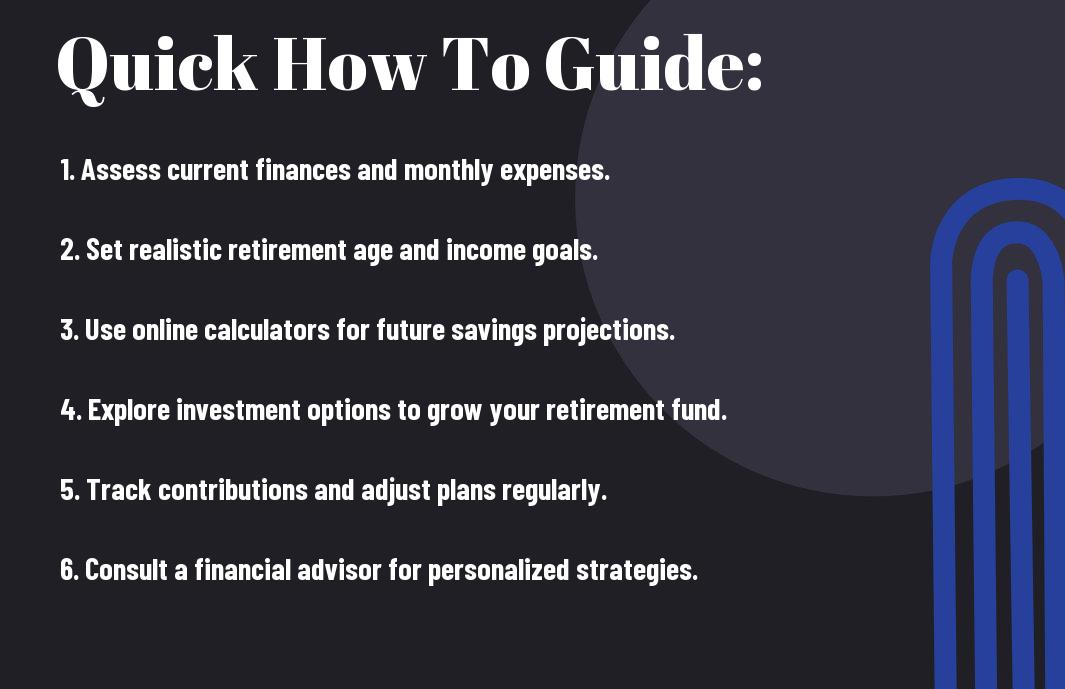Retirement planning can feel overwhelming, but with the right tools, you can make this transition smoother and more secure. By utilizing various resources and strategies, you can effectively manage your finances while focusing on your lifestyle goals. From budgeting apps to investment calculators, these smart tools will empower you to take control of your retirement journey. This guide will walk you through the important steps to set yourself up for a financially stable and fulfilling retirement.
Key Takeaways:
- Utilize retirement calculators to estimate future needs and assess how much you should save monthly.
- Explore budgeting apps that help track expenses and manage savings effectively, ensuring you stay on course towards your retirement goals.
- Consider investment platforms that offer retirement-specific tools and advice to optimize your portfolio for long-term growth.
The Digital Tools Revolutionizing Retirement Planning
Advancements in technology have transformed retirement planning, making it more accessible and convenient than ever. Digital tools enable you to analyze your financial situation, explore different investment strategies, and project your potential retirement outcomes. As these platforms evolve, they offer innovative features that allow for personalized planning and real-time adjustments based on your changing circumstances.
Software Solutions: Key Features and Benefits
Various software solutions now come equipped with features designed to enhance your retirement planning experience. These programs often include:
- Customizable simulations that forecast your financial trajectory based on different inputs.
- Expense tracking to help you visualize how your current spending affects future savings.
- Investment advice tailored to your risk tolerance and retirement goals.
- Scenario planning to understand the impact of major life events on your retirement plans.
- User-friendly interfaces making navigation straightforward, even for those less tech-savvy.
Assume that utilizing one or more of these software tools can significantly streamline your planning process, leading to informed and confident retirement decisions.
Mobile Applications: Planning on the Go
With mobile applications, you can take control of your retirement planning anytime, anywhere. These apps empower you to monitor your progress, adjust your investments, and stay on top of your financial health, all from the convenience of your smartphone. Many allow you to set up alerts for market changes, ensuring you never miss an opportunity to enhance your portfolio or adjust your savings approach. Integrated calculators help you evaluate the immediate impact of financial decisions, fostering a proactive attitude towards your retirement strategy.

Crafting Your Personalized Retirement Strategy
Your retirement strategy should be as unique as you are, tailored to fit your specific needs and aspirations. Begin by assessing your current financial assets, such as savings, investments, and real estate, alongside any liabilities like debt. This foundational understanding enables you to map out the financial landscape you’ll navigate in retirement. From here, aligning your investments and savings with your desired lifestyle will create a compelling and achievable roadmap for your retirement journey.
Assessing Your Current Financial Landscape
Start by taking stock of your income sources, assets, and debts. Analyzing your budget, retirement accounts, and any potential pensions or Social Security benefits is crucial. Knowing exactly what you have will allow you to gauge how much more you need to secure your desired retirement lifestyle.
Identifying Retirement Goals and Lifestyle Aspirations
Defining your retirement goals will help you understand what you need to save. Whether you envision traveling the world, starting a new business, or spending time with family, clarifying these aspirations informs your financial strategy. Quantifying these dreams will provide a target to aim for, ensuring your planning is effective.
Consider the lifestyle you wish to maintain in retirement—will you relocate, downsize your home, or take up a new hobby? For example, if you dream of retiring in a beachfront condominium, research the costs associated with that lifestyle, including property taxes and homeowners’ association fees. Knowing how much your retirement dreams will require will serve as a foundation for how much you need to save and invest each year. Establish a timeline for your goals, breaking them down into short-term and long-term objectives, which will help you prioritize your financial decisions effectively.
Risk Management: Tools for Protecting Your Future
Effective risk management protects your retirement savings from unforeseen threats, ensuring that your financial future remains secure. Utilizing smart tools can help you identify potential risks and formulate strategies to mitigate them. By understanding your risk tolerance and employing various protective measures, you can safeguard your assets against market volatility, health emergencies, and other unexpected life events.
Investment Simulators: Understanding Market Fluctuations
Investment simulators provide you with a hands-on approach to grasp how market fluctuations can impact your portfolio. By creating virtual investment scenarios, you can explore the potential effects of different strategies without risking your hard-earned savings. This experiential learning empowers you to make knowledgeable decisions, enhancing your confidence in approaching real-world investments.
Insurance Calculators: Ensuring Adequate Coverage
Insurance calculators help you assess the appropriate level of coverage needed to protect your family and assets. By entering relevant data regarding your income, savings, and liabilities, you can determine how much life, health, or property insurance is necessary to maintain your standard of living after an unexpected event.
Using insurance calculators is straightforward and highly informative. For example, if you input your current annual income and expected future expenses, the calculator can estimate how much life insurance coverage you’ll need to ensure your loved ones remain financially stable. Additionally, some calculators go further by suggesting premium costs, helping you budget accordingly. Understanding these numbers allows you to proactively secure your financial future against unforeseen adversities while ensuring your retirement plans remain intact.
Navigating the Complexities of Social Security
Understanding Social Security can feel overwhelming, but taking the time to learn the ins and outs can lead to significant benefits. Your lifetime earnings, the age at which you choose to retire, and your marital status all play a role in determining the amount you’ll receive. Knowing how these factors interact allows you to make informed choices that can secure a stronger financial future. Staying updated on changes in Social Security regulations can also help enhance your overall retirement planning.
Tools for Maximizing Your Benefits
Online calculators and benefits estimators are invaluable tools for determining your Social Security entitlements. Websites like the Social Security Administration offer calculators that allow you to input your earning history and projected retirement age to estimate your monthly benefits. Additionally, financial planning software can help you analyze various scenarios, including how different retirement ages might influence your payouts. Using these tools ensures you have a clear picture of what to expect.
Strategies for Timing Your Claims
Choosing when to claim Social Security benefits can dramatically impact your monthly income. Delaying your claim past the minimum age of 62 can lead to increased monthly benefits, with an average 8% increase for each year you wait until 70. This strategy allows you to accumulate a higher benefit amount, especially if you expect to live into your 80s or beyond. Conversely, if you have health concerns or financial pressures, claiming early may be necessary, despite receiving a reduced benefit.
Timing your claims isn’t just about waiting longer; it also involves understanding your unique financial and health circumstances. For example, if you anticipate a lower life expectancy due to health issues, claiming early may make sense, allowing you to access funds sooner. On the other hand, if you have adequate savings and a family history of longevity, delaying benefits can ultimately yield more substantial payouts. Evaluating these factors and possibly consulting a financial advisor can ensure that your claiming strategy aligns with your overall retirement plan.
Ongoing Assessment: Adjusting Your Plan with Smart Tools
Continuous assessment of your retirement plan allows you to stay on track toward your goals. Utilizing smart tools ensures that you can easily modify your financial blueprint as life circumstances change. Regular reviews and updates can prevent deviations from your intended path, helping to maintain your financial wellness even as unexpected life events unfold.
Tracking Progress: Measuring Your Financial Health
Measuring your financial health involves regularly monitoring investment performance, tracking expenses, and reviewing your savings rate. Use budgeting apps and portfolio trackers that provide real-time data, allowing you to visualize your progress toward retirement goals. Setting milestones within these tools can help maintain motivation and ensure you’re on target.
Using Analytics to Make Informed Adjustments
An analytical approach to your retirement plan helps identify trends and gaps in your financial strategy. By leveraging data analytics, you can adjust your contributions, alters your investment strategies, or shift your focus based on market fluctuations and personal needs. Access to real-time information empowers you to make smart decisions rather than relying on assumptions.
Incorporating sophisticated analytics tools into your retirement planning enables deep dives into your financial data, revealing patterns that could otherwise go unnoticed. For example, if your expense tracking indicates a consistent overspending habit, you can promptly adjust your budget or reassess your leisure expenditures. Analytics can also help project how long your savings might last under various scenarios, giving you clearer insights into whether you need to increase savings or consider alternative income options. By reacting promptly to data insights, you enhance your ability to navigate your financial future effectively.
Final Words
So, as you chart your course for retirement, leveraging these smart tools can significantly enhance your planning process. By utilizing calculators, budgeting apps, and investment platforms, you can create a personalized strategy that aligns with your financial goals. Stay informed and regularly review your progress to ensure you’re on track. With the right tools and a proactive approach, you can build a secure and fulfilling retirement that reflects your aspirations.
Q: What are some effective tools for retirement planning?
A: There are several effective tools designed to help individuals plan for retirement. Some popular options include retirement calculators, which can estimate how much you need to save based on your desired retirement age and lifestyle. Budgeting apps can track your spending and savings, helping you allocate funds toward retirement. Investment platforms also provide resources for managing retirement accounts and projecting future growth based on various investment strategies. Lastly, financial planning software can offer comprehensive insights into your retirement goals and the impact of different scenarios on your financial health.
Q: How can I assess my retirement savings needs?
A: Assessing retirement savings needs involves evaluating your current financial situation alongside your expected future expenses. Start by calculating your projected living expenses in retirement, considering factors such as housing costs, healthcare, and lifestyle preferences. Next, think about income sources during retirement, including social security, pensions, and savings. Financial advisors often recommend aiming for 70-80% of your pre-retirement income as a guideline. Utilizing retirement calculators can help in determining how much you should save annually to meet these goals, taking into account inflation and potential investment growth.
Q: What role do investment strategies play in retirement planning?
A: Investment strategies are a significant component of retirement planning as they influence how your savings grow over time. Different strategies involve varying levels of risk and potential returns. For example, younger individuals may focus on growth-oriented investments, such as stocks, that have the potential for higher returns over a longer time frame. As retirement nears, many advisors advocate for a more conservative approach, shifting funds into bonds or other less volatile investments to preserve capital. Tools like robo-advisors can help automate and optimize your investment strategy based on your risk tolerance and retirement timeline, ensuring your portfolio remains aligned with your goals.

Recent Comments